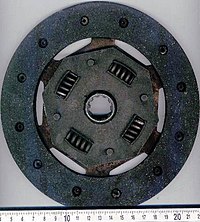
Photo from wikipedia
A heat transfer model of a wet multi-plate clutch based on empirical data is presented in this paper. Lumped system analysis was used to simplify the complex heat transfer system… Click to show full abstract
A heat transfer model of a wet multi-plate clutch based on empirical data is presented in this paper. Lumped system analysis was used to simplify the complex heat transfer system of the wet clutch. The model has included the effects of various design parameters of the wet clutch, such as rotating speed, flow rate and inlet temperature of the lubricant, clutch sizes, and groove types, by using the correlations of the heat convection coefficient. The correlations were obtained from 96 experiments that were designed to study the effects of the design parameters. The coefficients of the correlations were determined by the non-dominated sorting genetic algorithm (NSGA-II) to minimize errors between the simulated and the experimental results. The simulated results were compared with the experimental results to demonstrate the validity of the model and the correlations by using the percentage error, the root-mean-square error, and the correlation coefficient. The validation parameters were in good agreement with the experimental results.
Journal Title: Proceedings of the Institution of Mechanical Engineers, Part D: Journal of Automobile Engineering
Year Published: 2018
Link to full text (if available)
Share on Social Media: Sign Up to like & get
recommendations!